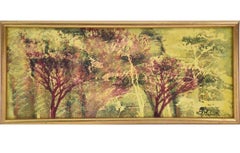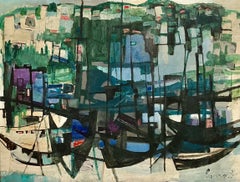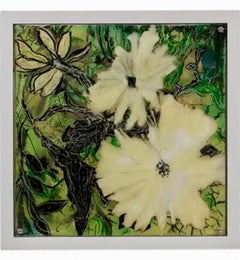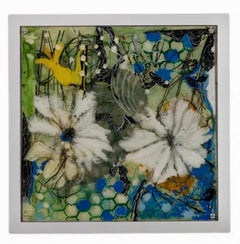Want more images or videos?
Request additional images or videos from the seller
1 of 9
Yuri Iosifovich Galetsky Post Soviet Avant Garde Russian Nonconformist Art Oil Painting Abstract Flowers1993
1993
Price:$650
About the Item
- Creator:Yuri Iosifovich Galetsky (1944, Russian)
- Creation Year:1993
- Dimensions:Height: 16 in (40.64 cm)Width: 20 in (50.8 cm)
- Condition:
- Gallery Location:Surfside, FL
- Reference Number:1stDibs: LU38210340442
About the Seller
4.9
Platinum Seller
Premium sellers with a 4.7+ rating and 24-hour response times
Established in 1995
1stDibs seller since 2014
1,819 sales on 1stDibs
Typical response time: 1 hour
Authenticity Guarantee
In the unlikely event there’s an issue with an item’s authenticity, contact us within 1 year for a full refund. DetailsMoney-Back Guarantee
If your item is not as described, is damaged in transit, or does not arrive, contact us within 7 days for a full refund. Details24-Hour Cancellation
You have a 24-hour grace period in which to reconsider your purchase, with no questions asked.Vetted Professional Sellers
Our world-class sellers must adhere to strict standards for service and quality, maintaining the integrity of our listings.Price-Match Guarantee
If you find that a seller listed the same item for a lower price elsewhere, we’ll match it.Trusted Global Delivery
Our best-in-class carrier network provides specialized shipping options worldwide, including custom delivery.You May Also Like
Original oil painting by prominent & searchable artist Steve McElroy.
By Steve McElroy
Located in Dallas, TX
This artist's butterfly work is in the current Veranda Magazine with Jan Showers.
"Sunflowers" oil on canvas original painting by Steve McElroy. 16 x 20...
Category
2010s Abstract Still-life Paintings
Materials
Canvas, Oil
$1,100
H 20 in W 16 in D 1.5 in
Original abstract oil painting by easily searchable artist Steve McElroy.
By Steve McElroy
Located in Dallas, TX
This artist's butterfly work is in the current Veranda magazine with Jan Showers.
"Kaleidoscope" by Steve McElroy original oil on panel painting. Remember Kaleidoscopes from child...
Category
2010s Abstract Abstract Paintings
Materials
Oil, Panel
$1,500
H 20 in W 20 in D 2 in
Original abstract oil painting by easily searchable artist Steve McElroy.
By Steve McElroy
Located in Dallas, TX
This artist's butterfly work is in the current Veranda Magazine with Jan Showers.
"Afternoon in Provence" oil on panel original panel painting by Steve McElroy. Framed and signed ...
Category
2010s Abstract Still-life Paintings
Materials
Oil, Panel
$1,750
H 24 in W 36 in D 3 in
Ralph Rosenborg "Rock Flowers" Signed Abstract Expressionist Oil, Framed 1965
By Ralph Rosenborg
Located in Miami, FL
RALPH ROSENBORG – "ROCK FLOWERS"
Oil on Canvas ⚜ Signed & Dated Lower Left & Verso ⚜ Float Frame
A VIBRANT EXPRESSIONIST WORK FROM A TRUE AMERICAN MODERNIST
In Rock Flowers, painted...
Category
1960s Abstract Expressionist Abstract Paintings
Materials
Oil
$4,800 Sale Price
40% Off
H 27.75 in W 24.625 in D 2.375 in
[Studies in Fragility] – Oil on Canvas Still Life by Paul Gorka, circa 1965
By Paul Gorka
Located in Miami, FL
PAUL GORKA – UNTITLED [STUDIES IN FRAGILITY]
Oil on Canvas ⚜ Signed Lower Right ⚜ Custom Conservation Frame
A COMPLEX, SYMBOLIC STILL LIFE OF MIDCENTURY AMERICAN INTROSPECTION
Untit...
Category
1960s American Realist Still-life Paintings
Materials
Canvas, Oil
$10,000
H 42 in W 54.125 in D 1.5 in
Hunt Slonem "Violet Spring" Purple and Green Flower
By Hunt Slonem
Located in Houston, TX
Hunt Slonem "Violet Spring" Purple and Green Flower
A single violet gestured in purple, yellow and green on a matching background in a vintage frame
Unframed: 10 x 8 inches
Framed: ...
Category
21st Century and Contemporary Neo-Expressionist Abstract Paintings
Materials
Oil, Panel
Ropes Oil and assemblage on board contemporary art
Located in Sitges, Barcelona
Title of the Artwork: Cuerdas
Artist: Paco Lagares
Technique: Oil and assemblage on board
Dimensions: 15 x 18 inches (unframed)
Period: 1970s (approx.)
Condition: Unframed
Provenance...
Category
1970s Contemporary Abstract Paintings
Materials
Oil, Board
$1,898 Sale Price
46% Off
H 14.97 in W 18.12 in
Cardboard/oil, 39x50 cm.
Located in Riga, LV
Aleksandr Rodin (1922-2001)
Painter Born in a family of farmers. Wife Rasma Lace - art scholar. Studied at the Stalingrad School of Art, Saratov Art School, graduated from the Depar...
Category
1980s Abstract Expressionist Abstract Paintings
Materials
Canvas, Oil
French Still-Life Tablescape.
Located in Cotignac, FR
Mid-century oil on canvas of a still-life tablescape by French artist F Descamps.
This artwork presents a captivating still life composition characterized by bold geometric forms an...
Category
Mid-20th Century Abstract Paintings
Materials
Canvas, Oil
"Wild and Beautiful II" - Colorful Impasto Abstract Floral Inspired Oil Painting
By Sveta Hessler
Located in Carmel, CA
Sveta Hessler (Russian, born 1973)
"Wild and Beautiful II" 2025
Oil Paint, Canvas, Stretcher Bars
The artist signed the back of the painting.
Sveta Hessler explodes the traditional ...
Category
2010s Expressionist Abstract Paintings
Materials
Canvas, Oil, Stretcher Bars
$9,750
H 36 in W 36 in D 1.5 in
More From This Seller
View AllMil Lubroth Mixed Media Oil Painting Contemporary Female Abstract Expressionist
By Mil Lubroth
Located in Surfside, FL
Mil Lubroth lived in New York, France,
Oil on board
Abstract expressionist Tree's in greens and purples
Provenance: Gallery Bique, Madrid. bears label verso
Dimensions: Frame Siz...
Category
Mid-20th Century Conceptual Abstract Paintings
Materials
Mixed Media, Oil
Large Polish Israeli Abstract Modernist Oil Painting Tel Aviv Harbor Mairovich
By Zvi Mairovich
Located in Surfside, FL
Zvi Mairovich. (Poland, Israel 1911-1974)
Large abstract harbor scene with boats. Vibrant colors. Oil on canvas. Hand signed lower right.
Tel Aviv, Jaffa harbour.
Canvas: 35.5 x 47....
Category
20th Century Abstract Abstract Paintings
Materials
Oil, Canvas
Eco Feminist Mixed Media Botanic Painting Mira Lehr Miami Abstract Expressionist
By Mira Lehr
Located in Surfside, FL
Mira Tager Lehr (American, 1936-2023),
Acrylic on canvas painting
Interrupted Cell Formation series
Circa 2008-2009.
Mixed media technique incorporating organic forms, floral motifs...
Category
Early 2000s Abstract Expressionist Abstract Paintings
Materials
Canvas, Mixed Media, Acrylic
Eco Feminist Mixed Media Botanic Painting Mira Lehr Miami Abstract Expressionist
By Mira Lehr
Located in Surfside, FL
Mira Tager Lehr (American, 1936-2023),
Acrylic on canvas painting
Interrupted Cell Formation series
Circa 2008-2009.
Mixed media technique incorporating organic forms, floral motifs...
Category
Early 2000s Abstract Expressionist Abstract Paintings
Materials
Canvas, Mixed Media, Acrylic
Abstract Still Life Oil Painting with Ink Theresa Bernstein Flowers in Vase
By Theresa Bernstein
Located in Surfside, FL
Theresa Bernstein, 1890 - 2002
Abstract Still Life Oil and Pen on Paper Painting (1994) by Theresa Bernstein
Frame: 26" X 22", Image: 18.5" X 14.75"
A Polish born American modernist figurative artist in the traditions of the Ashcan and New York Realism Schools, wife of William Meyerowitz. The artwork represents a still life with two flower vases. Signed by the artist and dated 1994 in the lower left.
Theresa Ferber Bernstein-Meyerowitz (1890 – 2002) was an American artist, writer, and supercentenarian born in Kraków, in what is now Poland, and raised in Philadelphia. She received her art training in Philadelphia and New York City. Over the course of nearly a century, she produced hundreds of paintings and other artwork, plus several books and journals.
Bernstein and her husband William Meyerowitz (a WPA, New deal artist), who was also an artist, lived and worked in Manhattan and Gloucester, Massachusetts. She painted portraits and scenes of daily life, plus reflections of the major issues of her time, in a modern style that evolved from realism to expressionism. She was active in several art associations and promoted her husband's work as well as her own. Her artworks are found in dozens of museums and private collections in the United States and abroad. She remained active all her life and was honored with a solo exhibition of 110 art works to celebrate her 110th birthday.
Bernstein also authored several books, including a biography of her husband and a journal about their many trips to Israel.
She died in 2002, just a couple of weeks short of her 112th birthday.
Theresa Ferber Bernstein was born in Cracow, Poland, on March 1, 1890. She was the only child of Isidore Bernstein, a Jewish textile...
Category
1990s Abstract Abstract Paintings
Materials
Paper, Oil, Pen
Flowers 1978, Op Art Floral Oil Tempera on Board Roses Pop Art Large Painting
By Lowell Nesbitt
Located in Surfside, FL
Lowell Nesbitt
(American, 1933-1993)
Flower, 1978
tempera on board
60 1/2 x 40 1/2 inches.
Provenance:
Sold: Christie's East, May 18, 1999, Lot 224
Blair Nesbitt is an American p...
Category
1970s Pop Art Still-life Paintings
Materials
Canvas, Oil



